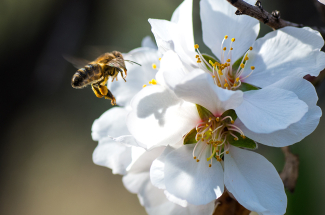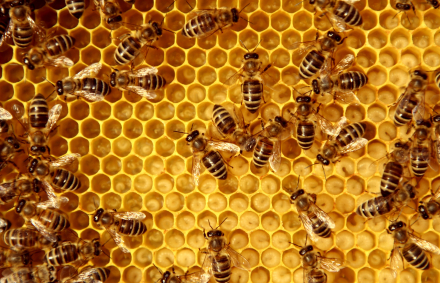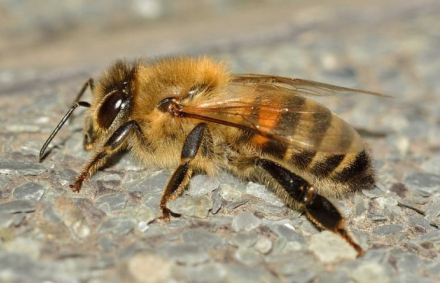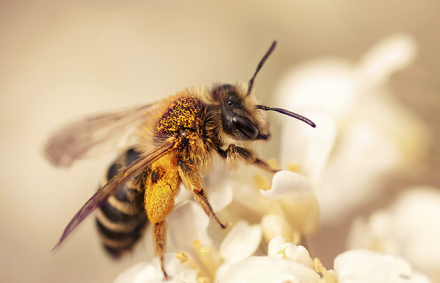
As W. Thompson said, “If you cannot measure it, you cannot improve it”. How does this apply to us? We have to know how many varroa mites we have to be able to make the rights decisions to control them.
Choosing the hives to sample.
In the previous posts "How to combat varroa in bees: know your enemy", and "Varroa, critical moments of action", we saw that varroa mites are not distributed uniformly among the hives in an apiary. Generally, 10% of hives have a lot more varroa than the others. It is therefore important to choose a sample that is representative of the situation.
As a baseline, we can inspect 10 hives/apiary. This would include all the hives in a small apiary and a percentage of between 10 and 20% in a large or medium size apiary, respectively. We should choose approximately half of those on either end of the apiary, where the bees enter, and half of those in the middle that have symptoms at the entrance (bees with wings damaged by DWV [deformed wing virus] extracted pupae, varroa in the cracks at the entrance, robbing, or very nervous bees).
Measuring varroa mites on adult bees.
We also saw in those posts that varroa mites from a certain hive will be distributed in about 1/4 of the adult bees, growing bigger, and the other 3/4 in the capped brood, breeding. We can therefore look for them in various hosts.
To have good data, we need to take around 300 adult bees from the brood chamber. They do not need to be counted; they can be weighed, at around 30 g. Or, an easier option is to measure the volume they take up, about 30 cc of the bee collection jar, and draw around the edges with a marker. Ideally, these 300 bees should be taken from 3 different quadrants, as one hive can have different quantities of varroa in different quadrants.
The steps to collect them are:
- remove about three frames with capped brood and check that the queen is not present
- in Layens, slide the bee collection jar on the honeycomb from top to bottom so the bees fall inside; in Langstroth or Dadant turn the frame 90° and slide the collection jar in the same way; in both cases, shake the bee collection jar from side to side to prevent the bees that have fallen inside from flying out
Once the bees are collected, we need to detach the varroa mites. More than 80% of the mites will be located on the lower rings of the abdomen and will not be visible (see the post "Varroa, meet your enemy"). We can do this with alcohol, which will kill both the bees and the mites, or with powdered sugar or CO2, which will allow the bees to survive.
- Using alcohol.
For this, we will need a container with mesh or perforations, allowing the varroa mites, which measure about 1.5 mm, to pass through, while the bees, which measure a little more than 4 mm in diameter, cannot. Add a few tablespoons of fresh powdered sugar to the container, and as before, shake gently in a circular motion for one minute. If possible to let rest for a few minutes, even better. The varroa mites will fall through the perforations or the mesh, and the sugar-coated bees can be returned to their hive, alive.
Cover the bees with isopropyl alcohol or methyl alcohol and shake gently with circular motions for one minute. The bees will float, and the varroa mites will sink to the bottom, where they can be counted. The container should be transparent so the varroa mites can be seen. The contents of the container can be filtered through a kitchen colander to collect the alcohol.
- Using powdered sugar.

To make it easy to count, the powdered sugar with the varroa mites can be placed on a tray (preferably white) and a little water can be added to dissolve it.
It is important that the powdered sugar be fresh and not caked.
This procedure may detach around 20% less varroa mites than the alcohol method.
Additionally, the varroa mites will still be alive, and must be destroyed.
- Using CO2.
This method is the same as the powdered sugar method, but the varroa mites will detach when they, along with the bees, are anaesthetized with the addition of CO2. Add the CO2 with the container closed (leaving the top cracked) and do not aim directly at the bees. Add for a few seconds until the bees stop moving. Then shake as in the other methods, and let rest for 15 seconds.
The bees will recover quickly from the anaesthesia. The varroa mites will as well, and must be destroyed.

The only remaining step is to make our decision, as explained in the post "Varroa, critical moments to act."
Measuring varroa mites on capped brood.
More varroa mites tend to be found in the sealed drone brood than in the worker bee brood, but it is more accurate to measure the percentage of infestation in the latter. This is because the drone brood is located around the edge of the brood nest, and the population of varroa mites will take some time to reach it. Once the mites reach this brood, they prefer it to the worker bee brood, but the percentages between the two vary greatly.
I
In this case, the steps are:
- remove three frames with capped brood, shaking the bees inside the hive
- with a cutter, or a very, very sharp uncapping knife, uncap a total of around 300 worker bee cells (spread out over the removed frames), preferably from the upper fourth of the front side of each frame (where there is the most chance of finding varroa mites)
- on the cover of a neighbouring hive, tap the strip of cappings that were cut to see if there are varroa mites there
- empty the uncapped cells, tapping against the cover of a neighbouring hive
- count the brown varroa mites (any that are white are immature)
- count the uncapped pupae, by hand, making groups of 10 and counting how many groups there are, or count the uncapped cells
It is important that the cut is clean, so that the cells empty completely.



Like with the measurement on adult worker bees, the % of varroa mites is calculated by dividing the number of varroa mites obtained by the approximate number of uncapped bee pupae and multiplying by 100.
The only remaining step is to make our decision, as explained in the post "Varroa, critical moments to act."



